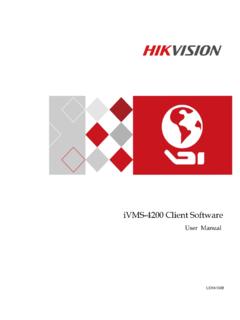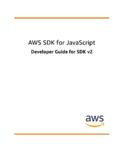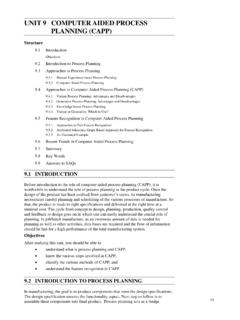Transcription of Operations and Supply Chain Simulation with AnyLogic 7
1 Ivanov D. (2016) Operations and Supply Chain Simulation with AnyLogic 1 Operations and Supply Chain Simulation with AnyLogic Decision-oriented introductory notes for management students in master programs Prof. Dr. Dmitry Ivanov Berlin School of Economics and Law Professor for Supply Chain Management To be cited as: Ivanov D. (2016). Operations and Supply Chain Simulation with AnyLogic : Decision-oriented introductory notes for master students. E-textbook, Berlin School of Economics and Law (preprint). Prof. Dr. Dmitry Ivanov, 2016. All rights reserved. Ivanov D. (2016) Operations and Supply Chain Simulation with AnyLogic 2 Content Introduction.
2 5 Part I Process capacity analysis and workload balancing 1. Business Simulation Game Process capacity analysis and workload balancing with AnyLogic .. 7 Learning objectives .. 7 Problem statement .. 7 2. Model building .. 8 Step 1. Create process model .. 8 Step 2. Define rules for incoming orders .. 9 Step 3. Define queue rules .. 10 Step 4. Define processing rules .. 10 Step 5. Create basic animation .. 11 Step 6. Simulation experiment .. 12 Step 7. Collecting statistics and KPI dashboard design .. 13 Revenue, costs, profit .. 13 Capacity utilization .. 15 Lead time and flow time .. 17 Backlog and queue analysis .. 18 3. Experiments and managerial insights.
3 21 Experiment 1 .. 21 Experiment 2 .. 22 Experiment 3 .. 25 4. Extensions .. 28 How to introduce the time limits for waiting in the queue .. 28 Interface creation for playing the game: views, sliders, parameters, variables, functions, and events .. 29 Views .. 29 Parameters .. 30 Variables .. 30 Functions .. 30 Events .. 31 Sliders .. 32 KPI dashboard creation .. 32 Resources .. 33 Ivanov D. (2016) Operations and Supply Chain Simulation with AnyLogic 3 5. Playing the game .. 34 Game rules .. 34 Round #1 .. 34 Round #2 .. 35 Round #2: Optimization experiment .. 37 Round #2: Optimization-based Simulation experiment: multiple objective decision making.
4 39 Rounds #3-#10 and game evaluation .. 41 6. Further possible extensions and other games .. 41 Part II Capacity flexibility Simulation 7. Business Simulation Game Capacity flexibility Simulation with AnyLogic .. 44 Learning objectives .. 44 Problem statement .. 44 8. Model building .. 46 Step 1. Create process model .. 46 Step 2. Create custom agent and define rules for order arrival, waiting, and processing: usage of time functions and resource pools .. 47 Step 3. Collecting statistics and KPI dashboard design .. 50 Revenue, costs, profit .. 50 Resource pool capacity utilization .. 50 Lead time with the use of time function .. 51 Total output, completed on time (OTD), delayed and lost orders: usage of Java code for conditions.
5 51 9. Playing the game .. 53 Game rules .. 53 Round #1 .. 54 Round #2 .. 55 Round #2: Optimization experiment .. 57 Round #2: Optimization-based Simulation experiment .. 57 Rounds #3 #10 and game evaluation .. 58 Capacity flexibility analysis .. 60 Ivanov D. (2016) Operations and Supply Chain Simulation with AnyLogic 4 Part III Supply Chain Coordination 10. Supply Chain Coordination with AnyLogic .. 65 Learning objectives .. 65 Problem statement .. 65 11 Model building .. 66 Create process model .. 66 Assembler .. 66 Transport with the help of Conveyor and MoveTo .. 67 Batch .. 67 12. Experiments and managerial insights.
6 68 Part IV Inventory Control 13. Modelling periodic and continuous review inventory control policies with 72 Learning objectives .. 72 Problem statement .. 72 14. Model building .. 73 EOQ model: event-based 73 Modelling stochastic demand: periodic and continuous review policies .. 75 Modelling stochastic demand and lead time: re-order point using Java .. 77 Inventory holding, ordering and stockout costs .. 79 Re-order point and safety stock .. 81 15. Experiments and managerial insights .. 84 Preparing experiment: using Action Charts .. 84 Preparing experiment: dynamic target inventory .. 86 Experiment 1 for engine oil: impact of demand dynamics.
7 89 Experiment 2 for nuts and bolts: impact of lead time dynamics .. 92 Experiment 3 for nuts and bolts: impact of order quantity .. 94 16. Extensions .. 96 Inventory management in Supply chains with production and transportation considerations: system dynamics .. 96 Agent-based modelling the market demand .. 96 17. Literature .. 97 18. Discussion .. 97 Ivanov D. (2016) Operations and Supply Chain Simulation with AnyLogic 5 Introduction This introductory note was created in order to support MBA and students with majors in Supply Chain and Operations management as well as instructors giving classes in Supply Chain and Operations Simulation for such students.
8 Without relying heavily on statistics and mathematical derivations, this guideline offers applied models and a simple, predictable format to make it easy to understand for management students without engineering background. While teaching management students in Simulation and optimization classes, it is a challenging task to combine modelling and management decision-making views. On one hand, application of optimization and Simulation software implies some background in programming. On the other hand, technical issues in development of optimization and Simulation models may distract the at-tention and time from the real objective, , management decision analysis and decision-making support with the help of Simulation and optimization software.
9 In this introductory note to Operations and Supply Chain Simulation using AnyLogic , the focus is to introduce the MBA and students into the basic principles of using Simulation for deci-sion-making. In reducing technical complexity to the necessary minimum, the main attention is paid to management decision analysis and using KPI for operational, customer and financial per-formance measurement for decision-making. The material is grouped into four parts that correspond to three basic process structures as well as basic inventory control policies: - Linear manufacturing system analysis - Single-stage manufacturing system analysis - Supply Chain network system analysis - Periodic and continuous review inventory control system analysis For these system structures, Simulation games are presented.
10 First, technical development of the models is described. Step-by-step, the process model building and KPI evaluation techniques are introduced and illustrated. Second, the developed models are used for playing the games and using Simulation results for decision-making. Finally, we discuss possible extensions that can be used for student assignments or master thesis. All the models and their source files can be downloaded at : Being focused on the management issues, the model developments are described as easy as possi-ble. At times, Simulation professionals would suggest more elegant but also more complicated ways to model building. In any case, this textbook has to provide elementary basics for Simulation model design and using the Simulation results for decision-making.






